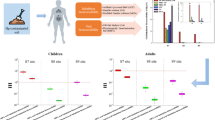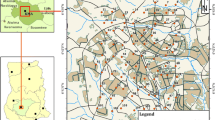Abstract
Ingestion of contaminated soils by children during hand-to-mouth activities can be a significant exposure pathway to toxic chemicals. Bioaccessibility, which corresponds to the fraction of an ingested contaminant dissolved in the gastrointestinal tract and potentially available for absorption, can be determined by in vitro extractions and gives a conservative value of relative oral bioavailability. The goal of this study was to investigate the validity of the CDM in vitro extraction protocol, developed by Camp Dresser and Mc Kee, by assessing the influence of soil properties and Hg fractionation on bioaccessibility. Mercury bioaccessibility was determined in two pure mercury compounds, two reference materials (a soil and a sediment), and three field-collected contaminated soils. Soils and reference materials were characterized and a sequential extraction procedure was applied to the samples. Bioaccessibility of HgCl2 was 99.8% in the gastric phase and 88.6% in the intestinal phase, whereas bioaccessibility of HgS was lower than 0.01%. In field-collected soils A, B, M, and, in ERM-CC580, mercury bioaccessibility was lower than 3.2% (below detection). In contrast, CRM 025–050 had a high Hg bioaccessibility (44.3% for gastric phase and 34.7% for intestinal phase). Gastric and intestinal bioaccessibility values were positively correlated with sulfate content in soils (r = 0.99, p < 0.001, for both gastric and intestinal bioaccessibility). In field-collected soils and ERM-CC580, the residual fraction represented near 100% of the mercury recovered, with less than 2% of mercury being in the water-soluble (F1) and CaCl2-exchangeable (F2) fractions. In contrast, 46% of mercury in the reference material CRM 025-050 was extracted in the CaCl2-exchangeable fraction. Results of the sequential extractions were in agreement with bioaccessibility values, with the sum of the water-soluble and CaCl2-exchangeable fractions (F1 + F2) highly correlated with intestinal bioaccessibility values (r = 0.99, p < 0.001). Hence, the sequential extraction procedure used in this study could be a simple means to help validate mercury bioaccessibility.

Similar content being viewed by others
References
Agency for Toxic Substances and Disease Registry (1999) Toxicological profile for mercury. Available at: http://www.atsdr.cdc.gov/toxprofiles/tp46.html
Akagi H, Nishimura H (1991) Speciation of mercury in the environment. In: Susuki T, Imura N, Clarkson TW (eds) Advances in mercury toxicology. Plenum Press, New York, pp 53–76
American Society for Testing Materials (2002) Standard test method for particle-size analysis of soils D422–D463
Andersson A (1979) Mercury in soils. In: Nriagu JO (ed) The biogeochemistry of mercury in the environment. Elsevier, North-Holland Biomedical Press, Amsterdam
Barnett MO, Turner RR (2001) Bioaccessibility of mercury in soils. Soil Sediment Contam 10:301–316. doi:10.1080/20015891109275
Barnett MO, Harris LA, Turner RR, Henson TJ, Melton RE, Stevenson RJ (1995) Characterization of mercury species in contaminated floodplain soils. Water Air Soil Pollut 80:1105–1108. doi:10.1007/BF01189771
Benoit JM, Gilmour CC, Mason RP, Heyes A (1999) Sulfide controls on mercury speciation and bioavailability to methylating bacteria in sediment pore waters. Environ Sci Technol 33:951–957. doi:10.1021/es9808200
Bernaus A, Gaona X, Van Ree D, Valiente M (2006) Determination of mercury in polluted soils surrounding a chlor-alkali plant—direct speciation by X-ray absorption spectroscopy techniques and preliminary geochemical characterisation of the area. Anal Chim Acta 565:73–80. doi:10.1016/j.aca.2006.02.020
Camp Dresser and Mc Kee Inc. (1992) Almaden Quicksilver County Park risk assessment, final report, Vol. II. Apendices. Denver
Canady RA, Hanley JE, Susten AS (1997) ATSDR science panel on the bioavailability of mercury in soils: lessons learned. Risk Anal 17:527–532. doi:10.1111/j.1539-6924.1997.tb00894.x
Carter MR (1993) Soil sampling and methods of analysis. Lewis, Ottawa, ON
CEAEQ (1997) Détermination du mercure: dosage par spectrophotométrie d’absorption atomique, formation de vapeur. MA. 200-Hg 1.0 (1–14)
Clesceri LS, Greenberg AE, Eaton AD (1999) 5310B total organic carbon (TOC), high-temperature combustion method. In: Clesceri LS, Greenberg AE, Eaton AD (eds) Standard methods for the examination of water and wastewater. American Public Health Association, Washington, DC
Counter SA, Buchanan LH (2004) Mercury exposure in children: a review. Toxicol Appl Pharmacol 198:209–230. doi:10.1016/j.taap. 2003.11.032
David RL (2002–2003) CRC handbook of chemistry and physics. 83. Chemical Rubber, Cleveland, OH
Davis A, Bloom NS, Hee SSQ (1997) The environmental geochemistry and bioaccessibility of mercury in soils and sediments: a review. Risk Anal 17:557–569. doi:10.1111/j.1539-6924.1997.tb00897.x
Drott A, Lambertsson L, Bjorn E, Skyllberg U (2007) Importance of dissolved neutral mercury sulfides for methyl mercury production in contaminated sediments. Environ Sci Technol 41:2270–2276. doi:10.1021/es061724z
Gabriel MC, Williamson DG (2004) Principal biogeochemical factors affecting the speciation and transport of mercury through the terrestrial environment. Environ Geochem Health 26:421–434. doi:10.1007/s10653-004-1308-0
Jay JA, Morel FMM, Hemond HF (2000) Mercury speciation in the presence of polysulfides. Environ Sci Technol 34:2196–2200. doi:10.1021/es9911115
John AD (1999) Table 3.2. Physical constants of inorganic compounds. McGraw-Hill, New York, pp 3.12–13.63
Kelley ME, Brauning SE, Schoof RA, Ruby MV (2002) Assessing oral bioavailability of metals in soil. Battelle Press, Colombus, OH
Maserti BE, Ferrara R (1991) Mercury in plants, soil and atmosphere near a chlor-alkali complex. Water Air Soil Pollut 56:15–20. doi:10.1007/BF00342257
Neculita C-M, Zagury GJ, Deschênes L (2005) Mercury speciation in highly contaminated soils from chlor-alkali plants using chemical extractions. J Environ Qual 34:255–262
Nusslein F, Feicht EA, Schulte-Hostede S, Seltmann U, Kettrup A (1995) Exposure analysis of the inhabitants living in the neighbourhood of a mercury-contaminated industrial site. Chemosphere 30:2241–2248. doi:10.1016/0045-6535(95)00097-R
Paquette K, Helz G (1995) Solubility of cinnabar (red Hgs) and implications for mercury speciation in sulfidic waters. Water Air Soil Pollut 80:1053–1056. doi:10.1007/BF01189765
Paustenbach DJ, Bruce GM, Chrostowski P (1997) Current views on the oral bioavailability of inorganic mercury in soil: implications for health risk assessments. Risk Anal 17:533–544. doi:10.1111/j.1539-6924.1997.tb00895.x
Pouschat P, Zagury GJ (2006) In vitro gastrointestinal bioavailability of arsenic in soils collected near CCA-treated utility poles. Environ Sci Technol 40:4317–4323. doi:10.1021/es0604156
Pouschat P, Zagury GJ (2008) Bioaccessibility of chromium and copper in soils collected near CCA-treated wood poles. Pract Period Hazard Toxic Radioact Waste Mgmt ASCE 12:216–223
Revis N, Holdsworth G, Bingham G, King A, Elmore J (1989a) An assessment of health risk associated with mercury in soil and sediment from East Fork Poplar Creek, Oak Ridge, Tennessee. Final report
Revis NW, Osborne TR, Holdsworth G, Hadden C (1989b) Distribution of mercury species in soil from a mercury-contaminated site. Water Air Soil Pollut 45:105–113
Revis NW, Osborne TR, Holdsworth G, Hadden C (1990) Mercury in soil—a method for assessing acceptable limits. Arch Environ Contam Toxicol 19:221–226. doi:10.1007/BF01056090
Rodrigues S, Pereira ME, Duarte AC, Ajmone-Marsan F, Davidson CM, Grcman H, Hossack I, Hursthouse AS, Ljung K, Martini C, Otabbong E, Reinoso R, Ruiz-Cortes E, Urquhart GJ, Vrscaj B (2006) Mercury in urban soils: a comparison of local spatial variability in six European cities. Sci Total Environ 368:926–936. doi:10.1016/j.scitotenv.2006.04.008
Rodriguez RR, Basta NT, Casteel SW, Pace LW (1999) An in vitro gastrointestinal method to estimate bioavailable arsenic in contaminated soils and solid media. Environ Sci Technol 33:642–649. doi:10.1021/es980631h
RTC (2006) Loamy sand—trace metals. Available at: http://www.rt-corp.com/products/n1064.aspx
Ruby MV (2004) Bioavailability of soil-borne chemicals: abiotic assessment tools. Hum Ecol Risk Assess 10:647–656
Sakamoto H, Tomiyasu T, Yonehara N (1995) The content and chemical forms of mercury in sediments from Kagoshima Bay, in comparison with Minamata Bay and Yatsushiro Sea, southwestern Japan. Geochem J 29:97–105
Schoof RA, Nielsen JB (1997) Evaluation of methods for assessing the oral bioavailability of inorganic mercury in soil. Risk Anal 17:545–555. doi:10.1111/j.1539-6924.1997.tb00896.x
Schuster E (1991) The behavior of mercury in the soil with special emphasis on complexation and adsorption processes—a review of the literature. Water Air Soil Pollut 56:667–680. doi:10.1007/BF00342308
Sobek AA, Schuller WA, Freeman JR, Smith RM (1978) Field and laboratory methods applicable to overburdens and mine soils. EPA-600/2-78-054 (60–62)
Soil Survey Division Staff (1993) Soil survey manual. Available at: http://soils.usda.gov/technical/manual/contents/chapter3e.html
U.S. Department of Energy (1994) East Fork Poplar Creek Sewer Line Beltway remedial investigation report. USDOE, Oak Ridge, TN
U.S. EPA (1995) Mercuric chloride (HgCl2) (CASRN 7487-94-7). Available at: http://www.epa.gov/iris/subst/0692.htm
U.S. EPA (1997) Volume IV: An assessment of exposure to mercury in the United States. Available at: http://www.epa.gov/mercury/report.htm
U.S. EPA (1997) Volume V: Health effects of mercury and mercury compounds. Available at: http://www.epa.gov/mercury/report.htm
U.S. EPA (2006) Child-specific exposure factors handbook (external review draft). Available at: http://cfpub.epa.gov/ncea/cfm/recordisplay.cfm?deid=56747
U.S. EPA (2007) Framework for metals risk assessment. Available at: http://cfpub.epa.gov/ncea/cfm/recordisplay.cfm?deid=167607
Zagury GJ, Neculita C-M, Bastien C, Deschênes L (2006) Mercury fractionation, bioavailability, and ecotoxicity in highly contaminated soils from chlor-alkali plants. Environ Toxicol Chem 25:1138–1147. doi:10.1897/05-302R.1
Acknowledgment
The authors gratefully acknowledge the financial support of the Natural Sciences and Engineering Research Council of Canada.
Author information
Authors and Affiliations
Corresponding author
Rights and permissions
About this article
Cite this article
Zagury, G.J., Bedeaux, C. & Welfringer, B. Influence of Mercury Speciation and Fractionation on Bioaccessibility in Soils. Arch Environ Contam Toxicol 56, 371–379 (2009). https://doi.org/10.1007/s00244-008-9205-7
Received:
Accepted:
Published:
Issue Date:
DOI: https://doi.org/10.1007/s00244-008-9205-7




